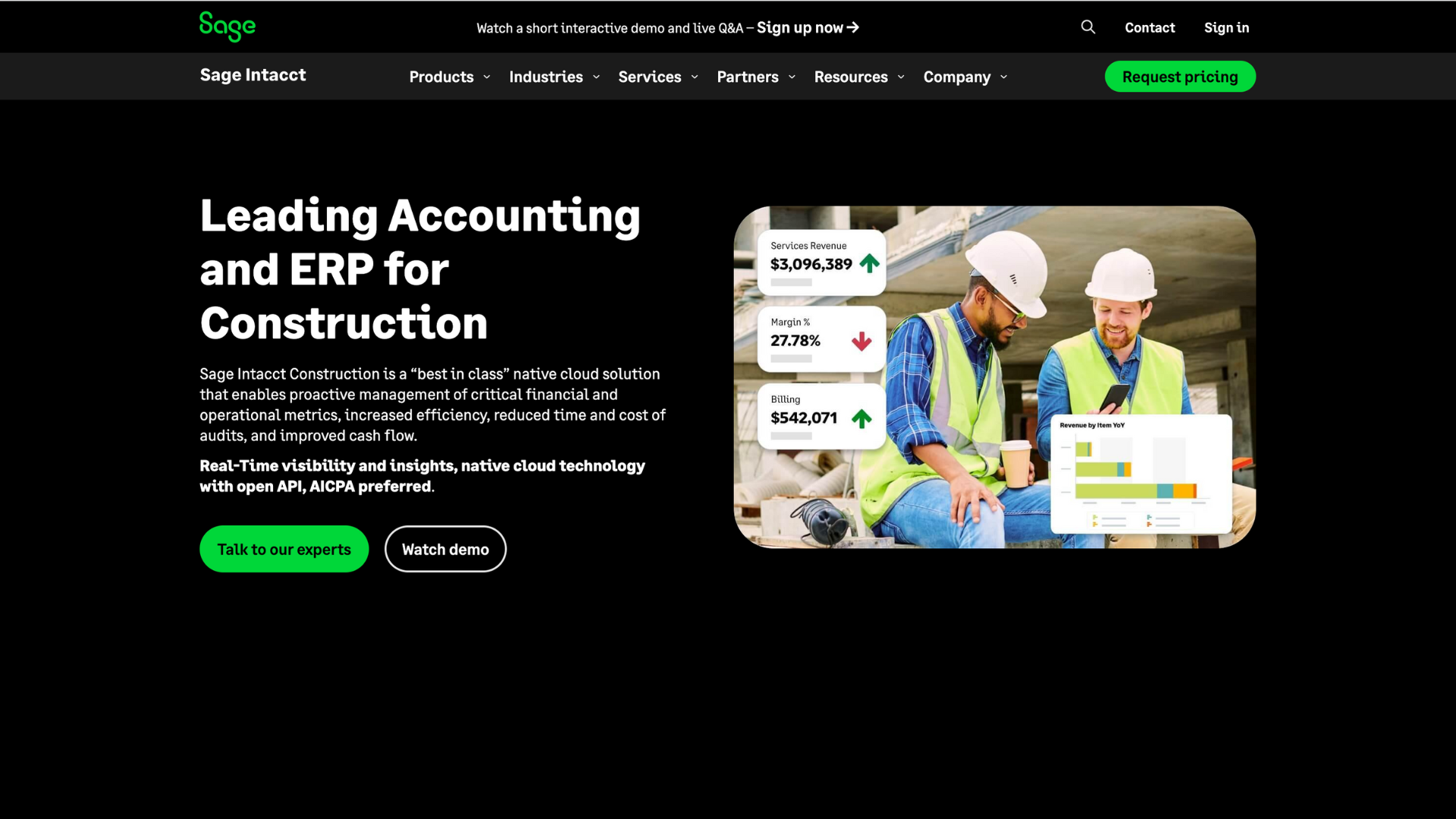Best Cloud Accounting Software for Construction Firms in 2022
Article by: Sockeye, a Sage Intacct Premier Partner
As a financial leader in a construction company, you need the agility to make decisions based on the real-time financial truth.
However, if you’re still using legacy accounting software that’s not purpose-built for the construction industry, your software may be holding you back.
There are two main reasons for this:
1. The big name software systems that still dominate the financial world (QuickBooks, Microsoft Dynamics, SAP, Oracle) were all developed before the Internet. They were never designed to provide real-time visibility into your organization’s financial and operational KPIs, or to be accessed remotely, or to have multiple users with different needs accessing them. Even if they now offer these features, they usually require costly, permanent customizations to do everything you need.
2. Legacy software systems weren’t designed to talk to other systems. Native, cloud-based accounting software is now designed to seamlessly hook into other solutions for project management, payroll, budgeting, customer relationship management, and dozens of other business functions. But legacy systems don’t have this capability. As a result, accounting professionals often end up having to export data from each system into spreadsheets and manually compile all their month-end reports in Excel.
Cloud-based construction accounting solutions were built for the always-on, always-connected, fast-paced environment that construction firms live and work in today. They provide real-time visibility into all your financial data, remote access, and enhanced security compared to on-premise solutions.
At Sockeye Consulting, we’ve helped hundreds of construction companies implement cloud-based accounting systems.
In this guide we’ll cover what to look for in a cloud-based construction accounting solution, and then we’ll provide an in-depth review of Sage Intacct, the cloud-based construction accounting platform that we sell and support. Finally, we’ll review six other construction accounting software products.
What to look for in a cloud construction accounting software solution
Modern cloud-based accounting solutions typically offer similar features when it comes to security, remote access, and the ability to assign different permissions to different users. These are major upgrades from most legacy on-premise construction accounting systems — and are often the driving factors in making the switch to the cloud.
The days of worrying about losing all your data from a ransomware attack or a natural disaster that wipes out your data center are over, and with remote-access you can access your accounting software from anywhere. With that remote-access feature comes the need for different user permissions: with most accounting systems, you can now create a wide variety of user permissions, allowing everything from time-card-only access to project-by-project access to full administrative access.
But the systems tend to be differentiated on three main factors, which we’ll dive into now.
General Accounting Software vs. Software that’s Purpose-Built for the Construction Industry
The nuances of construction accounting make it absolutely essential to use an accounting or ERP system that is purpose-built for the construction industry. In addition to the essential features of a general accounting system (general ledger, accounts payable, accounts receivable, purchase orders, etc.), software that is designed for the construction industry typically comes with construction-specific features like job costing, project accounting, and specialized progress billing.
These built-in features let you organize data by job, cost code, and cost type, as well as manage multi-entity company structures from a single account. You’ll also be able to quickly produce all the construction-specific reports you’ll need like WIP statements, over/under billings, and retainage, just to name a few.
General accounting software can sometimes be configured to do project accounting, but many construction businesses find that the workarounds and customizations required create reporting headaches.

Vista Construction Software by Viewpoint (now owned by Trimble) is an enterprise construction accounting system that takes an all-in-one approach, offering project management tools, job costing modules, employee management solutions, and construction data and reporting. Its pre-built reports include contract summary reports, progress billing reports, job code by phase reports, cost type reports, and more.
You can manage your entire construction business with one software suite, but its limited integrations mean you may have to switch from whichever best-in-class systems you were using, even if they were serving you well.
Purpose-built for construction: Yes
All-in-One Solution or Accounting Best-In-Class: All-in-One
Integration Marketplace: 49 integrations
Pricing & Support: No online transparency about pricing, but their interactive calculator asks how many people are in your company and how many projects you expect to complete per year. Direct support is available through a 24/7 Customer Portal, which includes phone support.
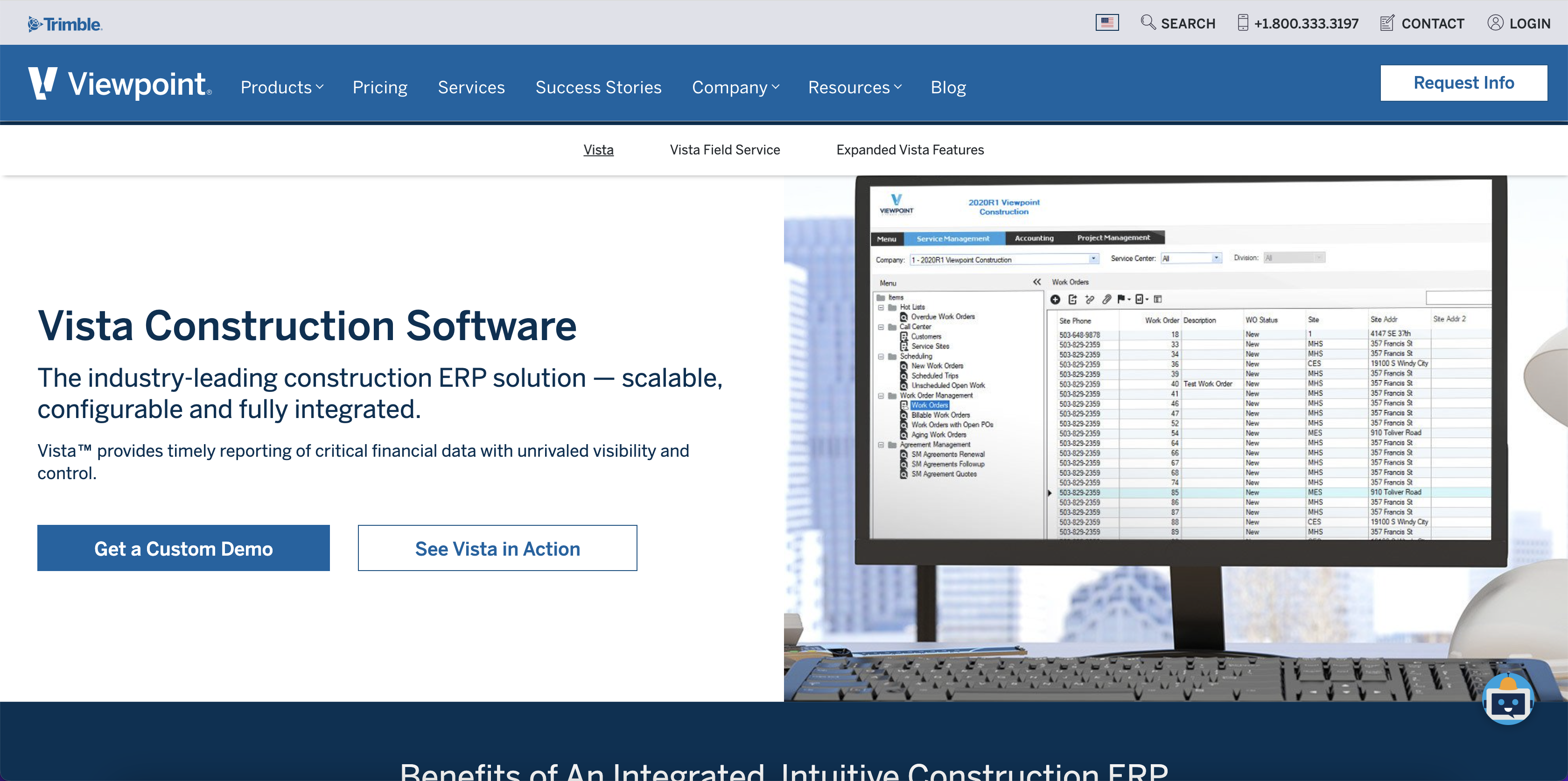

NetSuite by Oracle was built as an all-in-one ERP system, with accounting, CRM, and HR capabilities. While its inventory management, supply chain, and warehouse management solutions are ranked among the best accounting software for those industries, construction is not one of the core industries it serves.
However, NetSuite offers integrations with many of the leading project management solutions such as ProCore and ScaleNorth. These integrations can help make up for construction accounting features like AIA billing management, retention and change order management, and job profitability reporting that Netsuite lacks.
Purpose-built for construction: Yes
All-in-One Solution or Accounting Best-In-Class: All-in-One
Integration Marketplace: 595 pre-built integrations
Pricing & Support: Users subscribe to NetSuite for an annual license fee. Your license is made up of three main components: core platform, optional modules, and number of users. There is also a one-time implementation fee for initial setup. NetSuite offers 24/7 direct support, internationally (although more severe problems can only be addressed during business hours).
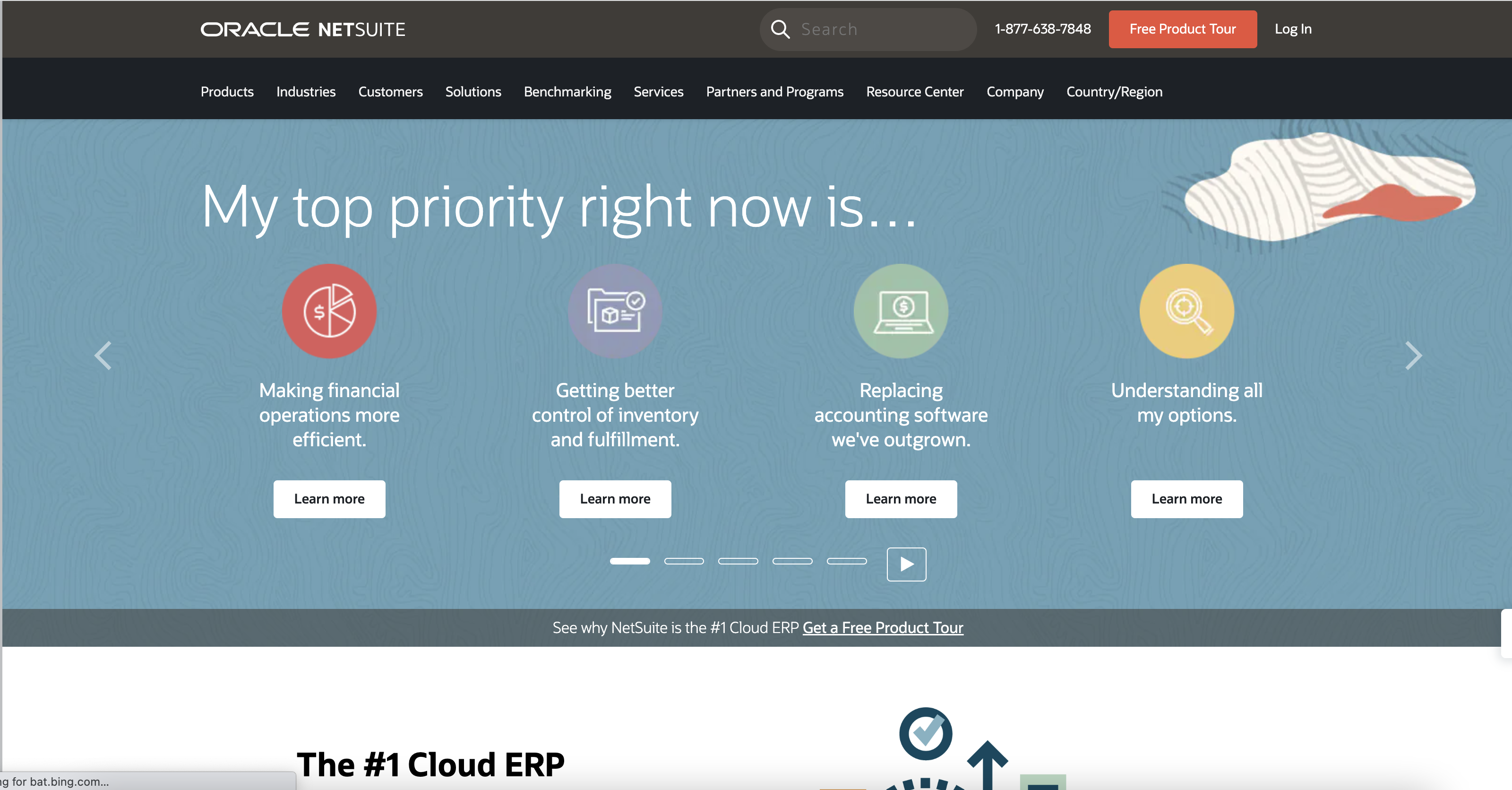

Acumatica is a cloud-based ERP system for construction companies with a built-in project management system. It offers real-time profitability analysis features that are helpful for any business that needs to track job costs against a budget.
Purpose-built for construction: Yes
All-in-One Solution or Accounting Best-In-Class: All-in-One
Integration Marketplace: More than 250 integrations
Pricing & Support: Pricing is based on usage, not user seats. Usage means both features accessed as well as data storage. Support from certified resellers, 24/7 access to call, chat, or email with the company (although reviewers note that direct support is slow to take action to resolve issues), community support.
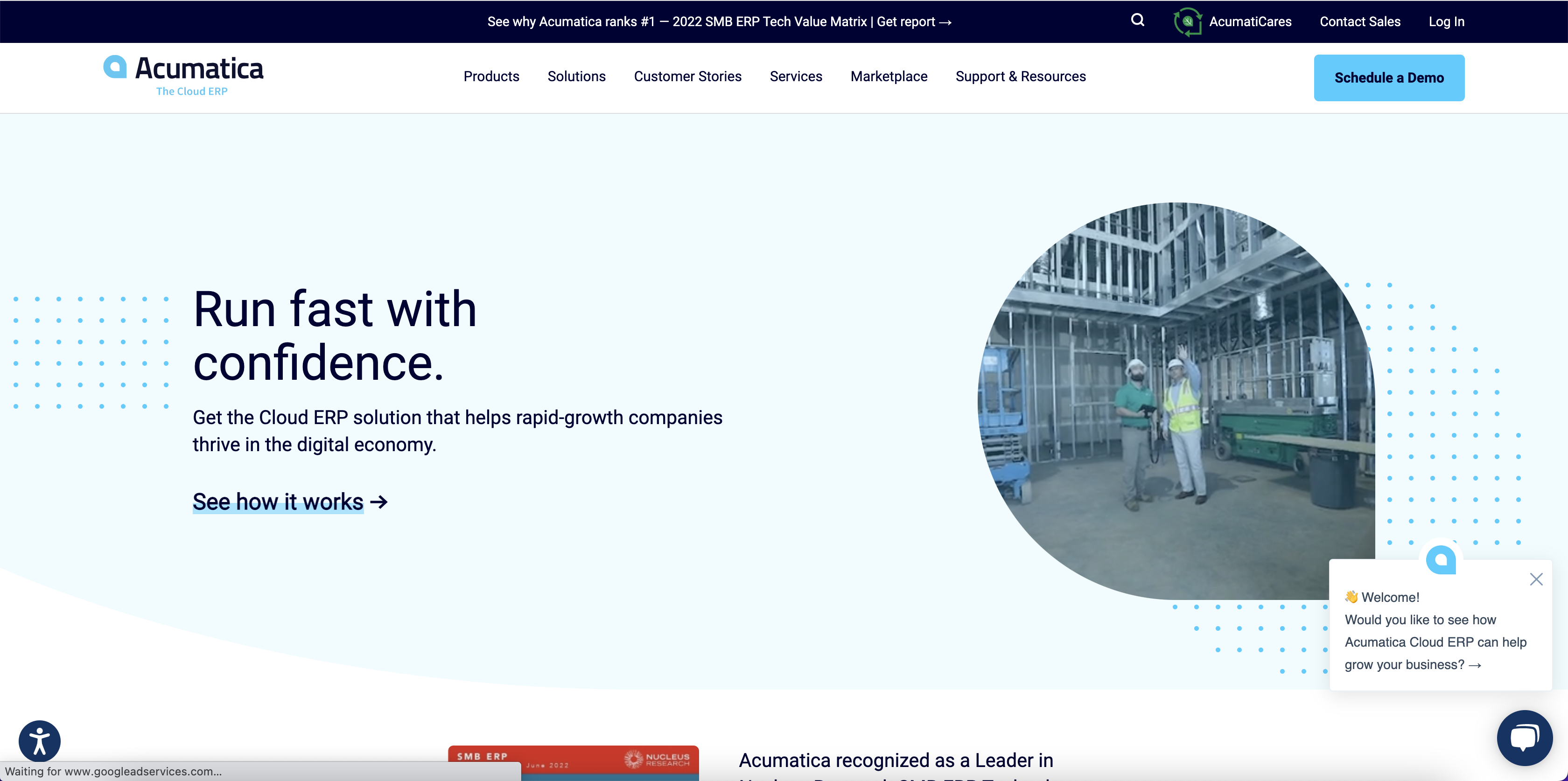

CMiC is an all-in-one construction management software, offering construction accounting, project management, and human capital management. While it integrates with leading project management solutions, it offers very few other integrations, since it aims to meet all your needs in one system.
Reviews mention that CMiC’s interface feels outdated, and that it lacks features to make data entry more efficient, leading to frequent data entry mistakes.
Purpose-built for construction: Yes
All-in-One Solution or Accounting Best-In-Class: All-in-One
Integration Marketplace: No, but CMiC does offer 6 out-of-the-box integrations
Pricing & Support: CMiC provides no information about pricing on their website. Direct support is available through an online customer portal or a 24-hour support line.
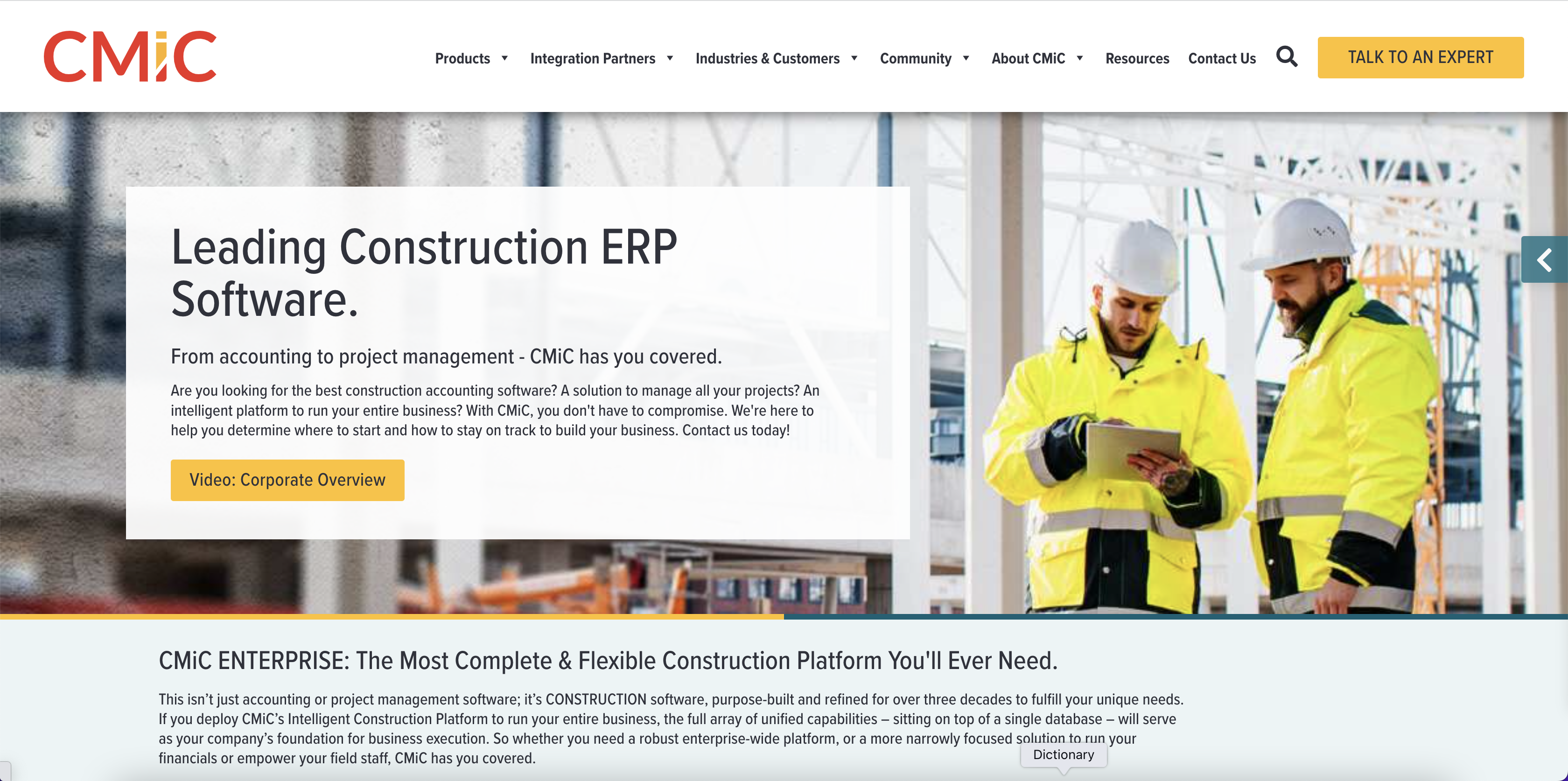

Known as one of the best accounting software options for small businesses, Quickbooks Online has an optional Projects module that can be used to track revenue and expenses by project, which opens it up to use by construction companies. It also has invoicing and time tracking features.
But without a dedicated job costing module, it requires a workaround in the QuickBooks Online Plus software to do job costing. It also can’t support multi-entity structures, and most users will still heavily rely on spreadsheets and manual reconciliation processes to produce their most complex financial reports.
Purpose-built for construction: Yes
All-in-One Solution or Accounting Best-In-Class: All-in-One
Integration Marketplace: More than 650
Pricing & Support: Free trial, 50% off discount on your first three months, then $80/month. Community support or online chat support only.
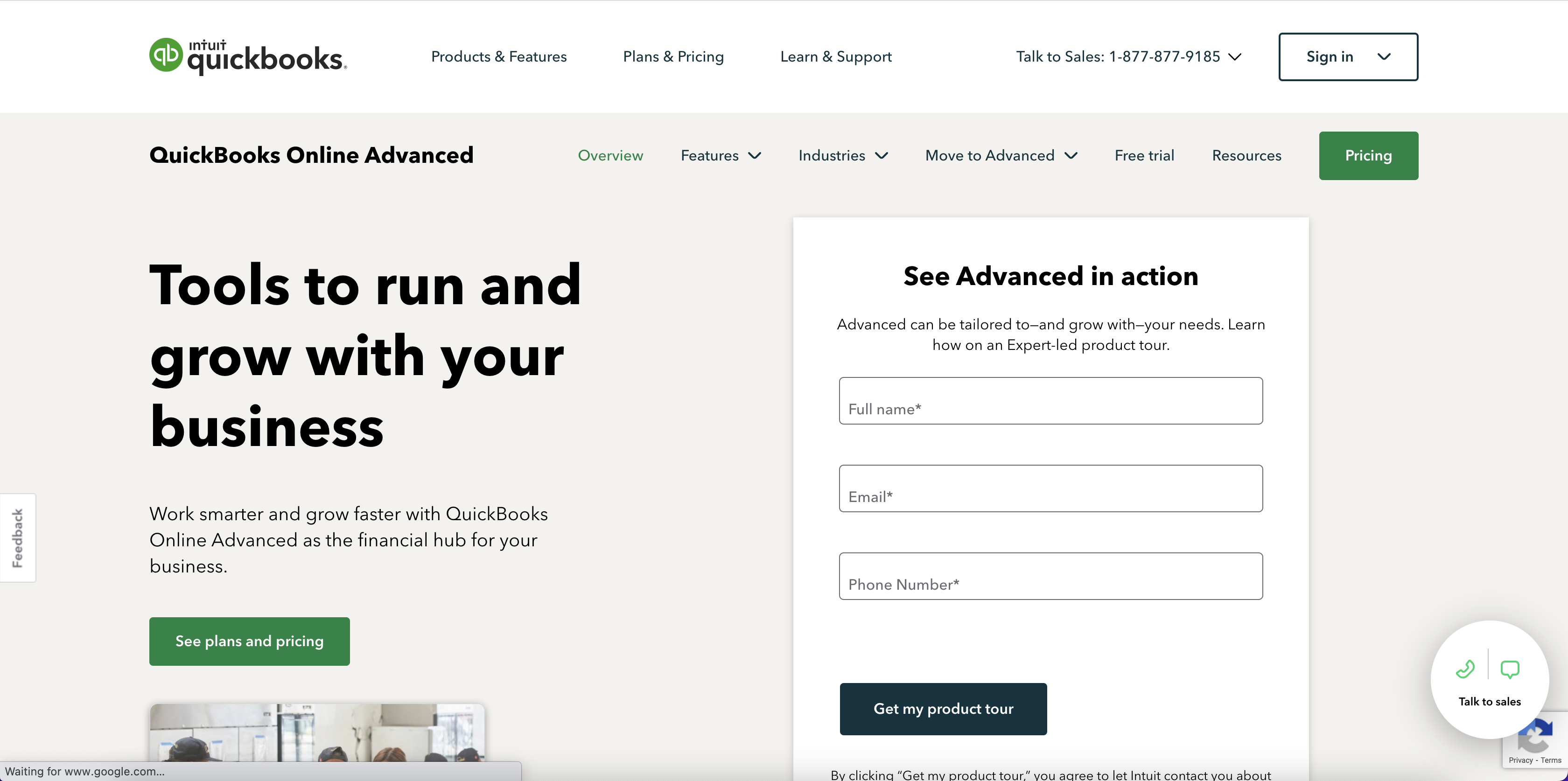

Jonas Premier is an all-in-one, cloud-based construction accounting, job cost, project management, document management, and drawing management solution from Jonas Construction Software.
The accounting software serves customers across the construction industry, such as general contractor/design build firms, construction management companies, land developers, custom home builders, civil and specialty contractors. With startup-friendly pricing, Jonas Premier generally targets smaller construction firms.
Purpose-built for construction: Yes
All-in-One Solution or Accounting Best-In-Class: All-in-One
Integration Marketplace: No (Premier only integrates with a few Microsoft products, ProEst, and Quickbooks Online Advanced)
Pricing & Support: Two pricing options, monthly or annual, based on the number of concurrent users (but you can have unlimited user logins). Monthly: $249 per concurrent user per month. Annual: $199 per concurrent user per month. On top of the subscription fee, there’s a $30,000 implementation fee, where the company manages the transition and provides six weeks of training, including group sessions and one-on-one training — and they offer a 30 day money back guarantee on the implementation cost. Support is available from 8 a.m. to 7 p.m. EST Monday to Friday.
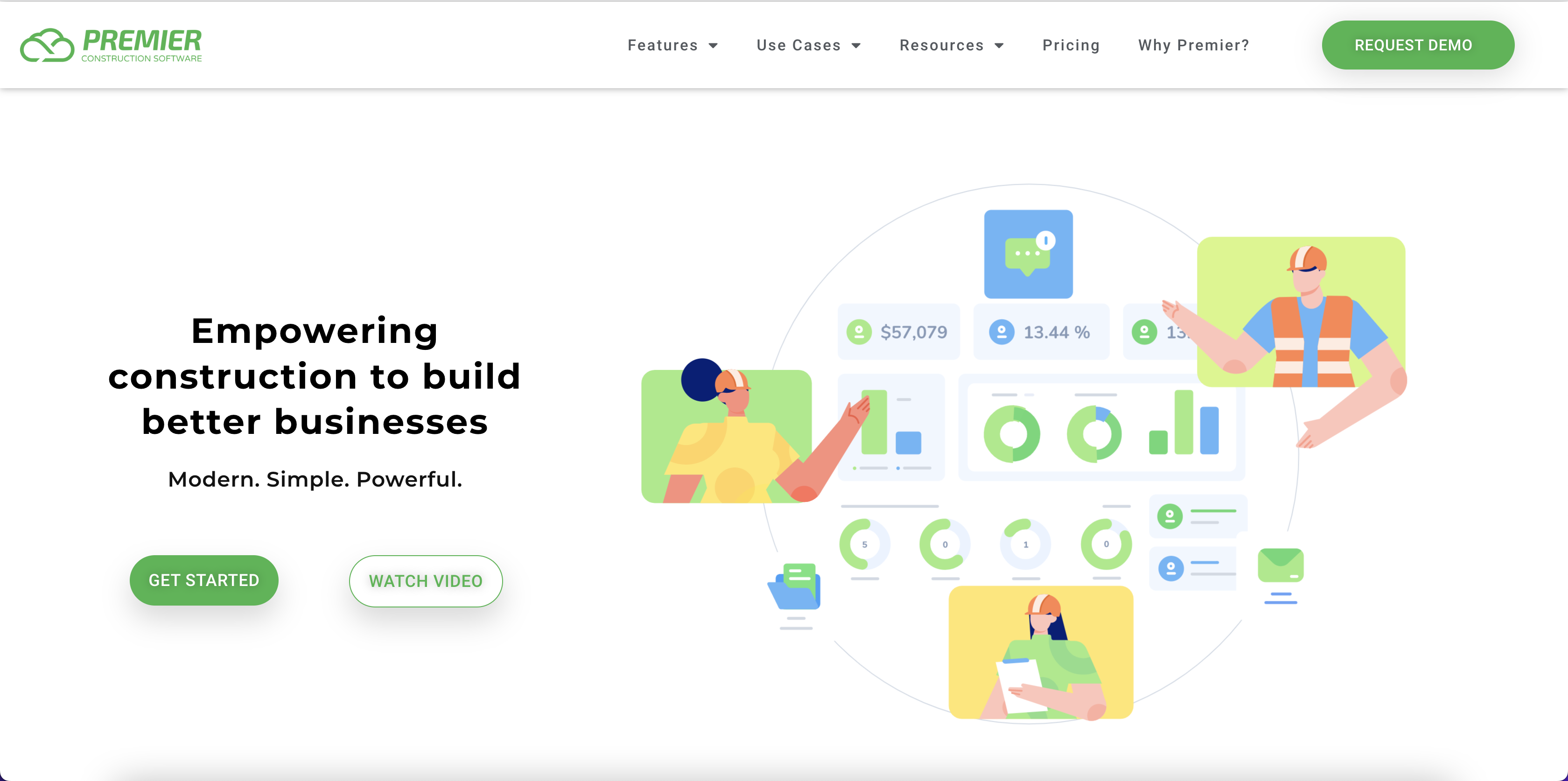
Make the Switch to Sage Intacct and Get Total Control of Your Project Financial Management
When you make the switch to Sage Intacct, you can expect to cut your close time in half each month. Finance teams typically see a productivity boost of 40 percent or more. And with Sockeye support, you’ll always have a trusted partner by your side making sure your software is helping you stay proactive and maximize your profitability.
Contact us for a one-on-one personalized demo today.Best Cloud Accounting Software for Construction Firms in 2023
Article by: Sockeye, a Sage Intacct Premier Partner
As a financial leader in a construction company, you need the agility to make decisions based on the real-time financial truth.
However, if you’re still using legacy accounting software that’s not purpose-built for the construction industry, your software may be holding you back.
There are two main reasons for this:
- The big name software systems that still dominate the financial world (QuickBooks, Microsoft Dynamics, SAP, Oracle) were all developed before the Internet. They were never designed to provide real-time visibility into your organization’s financial and operational KPIs, or to be accessed remotely, or to have multiple users with different needs accessing them. Even if they now offer these features, they usually require costly, permanent customizations to do everything you need.
- Legacy software systems weren’t designed to talk to other systems. Native, cloud-based accounting software is now designed to seamlessly hook into other solutions for project management, payroll, budgeting, customer relationship management, and dozens of other business functions. But legacy systems don’t have this capability. As a result, accounting professionals often end up having to export data from each system into spreadsheets and manually compile all their month-end reports in Excel.
Cloud-based construction accounting solutions were built for the always-on, always-connected, fast-paced environment that construction firms live and work in today. They provide real-time visibility into all your financial data, remote access, and enhanced security compared to on-premise solutions.
At Sockeye Consulting, we’ve helped hundreds of construction companies implement cloud-based accounting systems.
In this guide we’ll cover what to look for in a cloud-based construction accounting solution, and then we’ll provide an in-depth review of Sage Intacct, the cloud-based construction accounting platform that we sell and support. Finally, we’ll review six other construction accounting software products.
What to look for in a cloud construction accounting software solution
Modern cloud-based accounting solutions typically offer similar features when it comes to security, remote access, and the ability to assign different permissions to different users. These are major upgrades from most legacy on-premise construction accounting systems — and are often the driving factors in making the switch to the cloud.
The days of worrying about losing all your data from a ransomware attack or a natural disaster that wipes out your data center are over, and with remote-access you can access your accounting software from anywhere. With that remote-access feature comes the need for different user permissions: with most accounting systems, you can now create a wide variety of user permissions, allowing everything from time-card-only access to project-by-project access to full administrative access.
But the systems tend to be differentiated on three main factors, which we’ll dive into now.
General Accounting Software vs. Software that’s Purpose-Built for the Construction Industry
The nuances of construction accounting make it absolutely essential to use an accounting or ERP system that is purpose-built for the construction industry. In addition to the essential features of a general accounting system (general ledger, accounts payable, accounts receivable, purchase orders, etc.), software that is designed for the construction industry typically comes with construction-specific features like job costing, project accounting, and specialized progress billing.
These built-in features let you organize data by job, cost code, and cost type, as well as manage multi-entity company structures from a single account. You’ll also be able to quickly produce all the construction-specific reports you’ll need like WIP statements, over/under billings, and retainage, just to name a few.
General accounting software can sometimes be configured to do project accounting, but many construction businesses find that the workarounds and customizations required create reporting headaches.
Best-In-Class Accounting System vs. All-In-One Construction Software
Before the cloud became the norm for new software applications, running every aspect of your construction business from one solution tended to offer a significant advantage over best-in-class options because it meant your payroll system, your construction accounting software system, your billing system, and your project management system could all talk to each other. In the days of on-premise enterprise software systems, getting two or three applications from separate vendors to talk to each other was a nightmare involving a significant amount of custom coding.
But with the advent of cloud computing, the advantage is now swinging toward best-in-class solutions that specialize in one area instead of trying to cover all aspects of the business. Most software applications offer open APIs, making it much easier to integrate software systems together seamlessly.
With this approach, companies can get the best construction accounting software, the best payroll software, the best construction project management solution, and the best CRM, and each system can talk to and pull data from each other with integrations.
One key factor to evaluate is the number of integrations each accounting software offers through its own marketplace. These marketplaces typically represent integrations that have been vetted by the software vendor, who certifies that they’re highly secure and free of bugs. The best-in-class solutions tend to have much larger integration marketplaces than the all-in-one options, which can make it easier to keep using any software solutions that are working well for you.
Pricing structure, onboarding process, and ongoing support
When you make the switch to the cloud, you trade small licensing fees and occasional upgrade fees for an annual subscription fee. But with cloud-based systems, you no longer have to provide your own IT infrastructure and staff. Typically, the total cost of ownership for cloud-computing systems is far lower than it is for on-premises and hosted systems.
Pricing can be based on number of users, features, entities, or other structures
While few enterprise accounting software providers share their full pricing structure transparently, most give an indication on their website of whether their pricing is based on number of users, feature usage, number of entities managed, or something else. Depending on the size and complexity of your construction company, the cost of each solution could vary drastically for you based on the different pricing structures.
Onboarding and customer success approaches vary
Because these software systems touch so many business units, the onboarding process can take anywhere from six weeks to six months, but the level of support each software manufacturer provides varies significantly.
Some vendors require a mandatory, flat-rate implementation fee (which can cost 10 times as much as the annual subscription fee). Other vendors provide a custom estimate for the onboarding process but then bill for time and materials in excess of the estimate. And finally, some vendors rely on a partner network to sell, onboard, and provide all ongoing customer support.
Again, when you switch to cloud-based software, you pivot from working with an internal IT team to working primarily with the vendor or their trusted partners to keep your system running smoothly. The level of support—and the industry-specific expertise of the customer support team—will have a huge impact on your long-term success with the product.
While Sage has been a household name in construction accounting software for almost four decades, the cloud-native Intacct solution represents a significant leap forward in security, ease of use, and productivity for all teams, not just your accounting department.
Why we recommend Sage Intacct Construction:
Reduce (or eliminate) reliance on spreadsheets at month end
With Sage Intacct, you can finally view all of your financial information in one dashboard without manually exporting data to spreadsheets and compiling it in Microsoft Excel. That’s because Sage Intacct has pre-built integrations with more than 350 software applications, including all of the top best-in-class solutions for payroll management, HR, customer relationship management, billing, and construction project management software. So you can keep whatever systems you’re using today, but ditch the manual, time-consuming process of compiling reports in Excel.
Sage Intacct can serve as your single source of truth for all your financial data. It gives you a consolidated view of all your reports, and each report gives you the option to drill down into each number to see the data and context behind it.
For example, from the Top Level dashboard, you can click on the card labeled Project Profit Margin. That will bring up a breakdown of where all profit for that specific construction project is coming from (total revenue, labor costs, material costs, etc.).
Any project costs that appear in blue text can be clicked on, allowing you to drill down again to see the individual transactions that make up those costs. You can continue this process all the way down to seeing which employees entered timesheets during the specified period, to the exact timesheet of each employee, along with whether it’s been approved and who approved it.
Manage multi-entity structures efficiently with dimensional general ledger
With Sage Intacct, your general ledger becomes an interactive, intelligent document, thanks to the power of dimensions. Dimensions are tags that can be attached to any transaction, such as job, cost code, and cost type, capturing the business context of each transaction. You can then sort reports by those dimensions (and many others).
Unlike general accounting software that isn’t built for construction, where you have to re-purpose labels like “item” or “product type” to track project costs, Sage Intacct makes job costing easy.
Additionally, the dimensions make it possible to manage multiple entities from one Top-Level dashboard.
For example, you could run both a developer side and a general contractor side of your construction business out of one Sage Intacct account, and see the profit margin for the combined company on the Top-Level dashboard, and then drill down into each company’s financial data separately with a few clicks.
Each entity can share information like the customer record, vendor record, and chart of accounts, so you don’t have to enter and maintain those records for each entity if they’re shared across the entire organization.
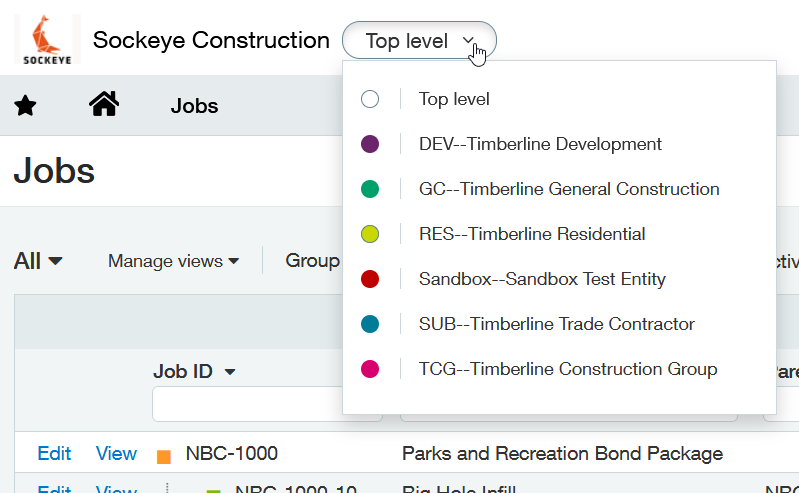
Produce your most challenging construction reports in minutes
Sage Intacct combines the construction-specific capabilities of its predecessors (Sage 100 Contractor and Sage 300 CRE) with new capabilities such as real-time reporting, dashboards, and KPIs, and advanced features such as deferred revenue management, project accounting, multi-currency and global consolidations. These new capabilities provide deep financial and operational insight to make financial reporting fast and accurate.
Like its predecessors, Sage Intacct can produce WIP statements, track over/under billings, and track and release retainage directly within the system without going through a reconciliation process. None of these reports require any custom coding or workarounds to produce, and they can be written directly inside the software. And with pre-configured integrations with other best-in-class applications such as Salesforce, AvidXchange, HR Solutions, Expense Report and countless others, you’ll never have to export the data to a PDF or Excel spreadsheet to do simple calculations.

Get real-time access to essential business metrics
The mobile solutions and electronic document management solutions that come with Sage Intacct make it so project managers can enter information into the system from the field and have it immediately update all relevant records across the entire system, whether it’s a change order, a timesheet, an invoice, or anything else.
This completely eliminates the hassle of field teams emailing or texting things like invoices and change orders to a team member in the office and asking them to manually enter the information into the system.
Avoid unexpected cash flow issues
Sage Intacct has several features that help you control spending and proactively manage cash flow.
Connect to any bank to automatically import transactions
With secure connections to thousands of financial institutions around the world, Sage Intacct can automatically import transactions from your financial institutions and automatically reconcile your checking, savings, and credit card accounts in just minutes. You’ll be able to see all payments and transactions across all checking and savings accounts and credit cards across locations and entities.
Reduce time-to-pay with EFT payments
Managing vendor payments is faster and easier with Sage Intacct’s Accounts Payable software module. It can handle both paper checks and EFT payments, without any add-on software. If you’ve been managing vendor payments with paper checks, switching to EFT payments can reduce time-to-pay by up to a week, helping you stretch out payments and improve cash flow.
Prevent transactions that exceed budget with spend management rules
Finally, you can create spend management rules that automatically check spend transactions against budget availability. Depending on your organization’s workflow, you can choose to automatically deny a transaction or simply trigger an onscreen warning any time there’s an overage. Additionally, you can set up email notifications that go directly to your budget administrator when transactions that exceed budget are recorded despite the onscreen warning.
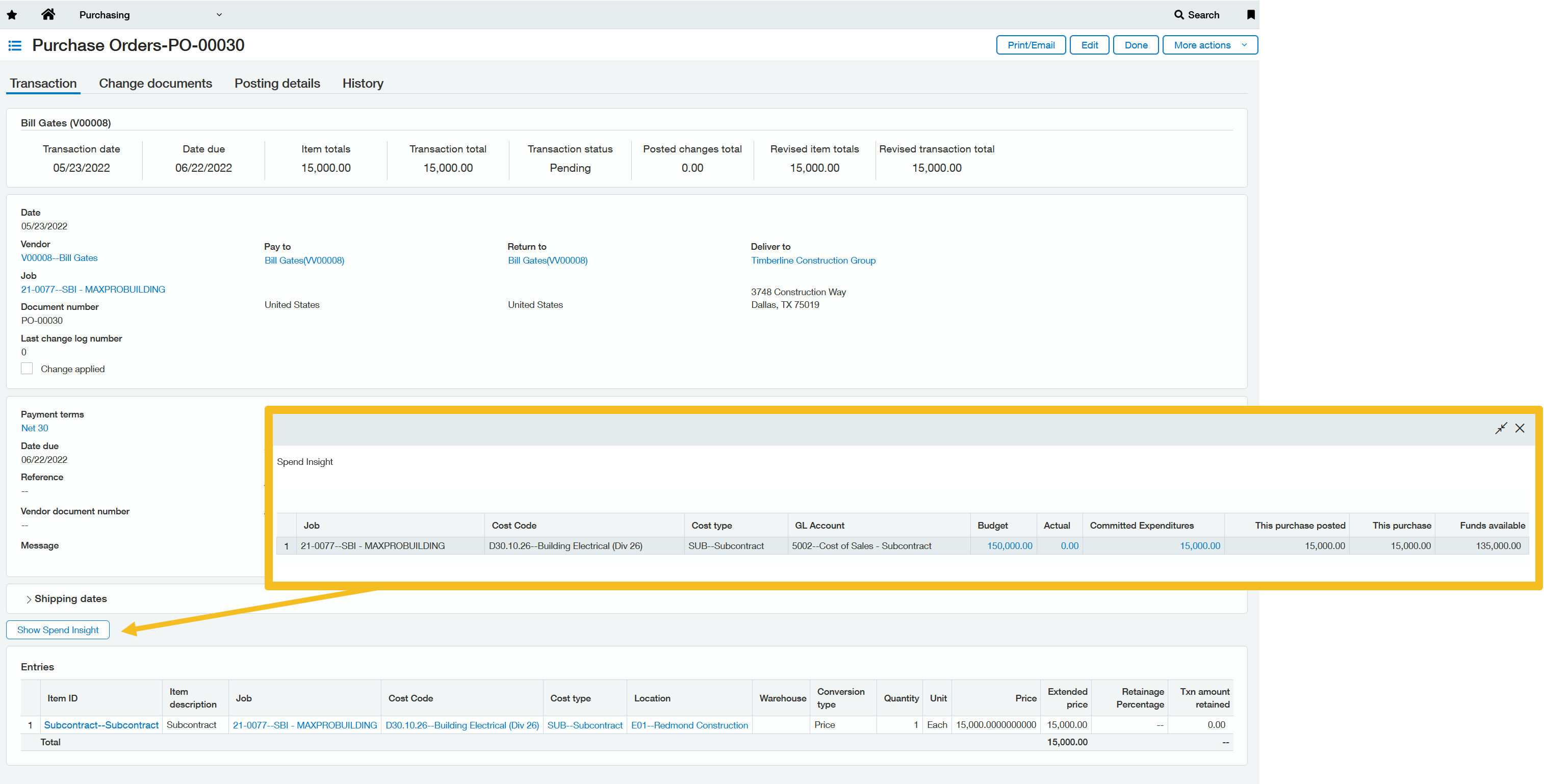
Create smarter estimates and improve profits with Project Costing and Billing
Sage Intacct Project Costing and Billing shows you the true cost of past construction projects, so you can see how your estimates compare to actuals. In Intacct, job cost reports are interactive, meaning you can drill down into any blue numbers to see a breakdown of all project costs, down to the task level.
With a few clicks, you could find out whether the cost overruns on a specific task were due to unexpected labor costs, materials costs, or other expenses—showing you exactly where to adjust your numbers to make more accurate estimates. And once a new project is finalized, you can turn your estimates into projects without manually re-entering the data.
The billing automation feature eliminates the usual headaches of manually formatting each invoice to meet the format and billing terms of each client. You can create custom invoice templates for each customer. And if you’re working on multiple projects for the same customer, you can even produce consolidated invoices that combine different billing terms for each project.
Browser-based solution provides familiar user interface
Switching software systems always comes with a learning curve, but Sage Intacct will feel familiar to users from the first time they login because the system is operated inside of a web browser.
Any user who’s already comfortable navigating websites like Amazon or Wikipedia will intuitively grasp the Sage Intacct user interface. They’ll find the same blue text that indicates a clickable hyperlink, browser tabs they can flip back and forth between to view separate dashboards, and a search bar in the top right corner.
Keep track of important decisions without email
On every individual record throughout the Intacct system, there’s a social media-style comment section at the bottom. This allows users to discuss reports and records within the software, and the conversation stays attached to that record forever, creating a permanent decision log.
For example, if the controller has a question about a new invoice, they can ask the question in the comment field below the invoice and tag the person who added the invoice. That person will get an email notification that they were tagged in a comment, and they’ll be able to respond to the thread. The conversion thread will always be attached to that invoice, preserving the decisions and explanations that were shared.
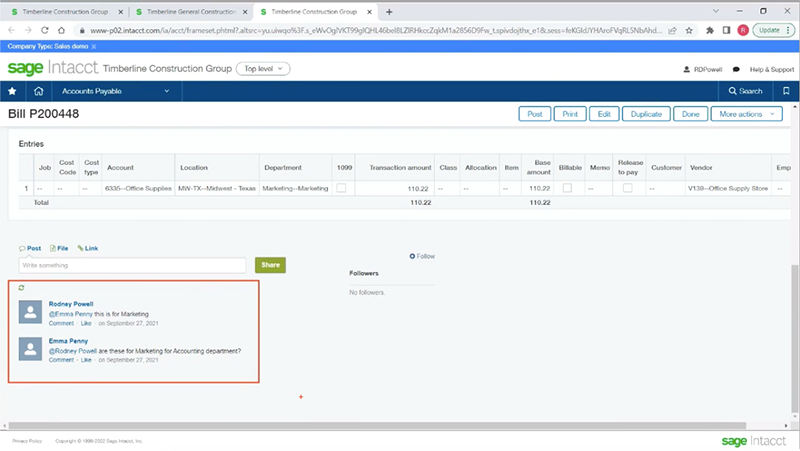
Streamline data entry and prevent human error
The business insights you can gain from any construction accounting software program are only as good as the data they’re based on. Fortunately, Sage Intacct has several features that make data entry fast, easy, and accurate.
Auto-fill reduces mouse movements
Any data entry form in Sage Intacct is programmed to auto-fill matching items. As you type, you’ll get a drop-down box showing matching items, such as project names, employee names, cost types, etc. This makes data entry fast and efficient by reducing the number of mouse movements required to input data.
User permissions prevent coding errors
Another way Sage Intacct helps prevent data entry errors is through user permissions. Sage Intacct lets you give different users different permissions, based on their role.
For example, users who only work on a single project can only see information relevant to that project. When that user tries to enter an expense, the drop-down box will only include the project they’re working on, so they’ll be much less likely to code the expense incorrectly.
Outlier detection catches potential errors
Finally, Sage Intacct incorporates machine learning to recognize patterns in how you use the system, which can help it detect data entry errors before they’re even submitted. If a user enters some data that Intacct considers to be outside the normal range (e.g. a higher dollar amount than usual, or an unusual combination of account and dollar amount, etc.) it will flag that input as an outlier.
You can configure how Intacct will handle outliers—it can automatically reject all outliers or just trigger a warning box to remind the user to double check the entry—according to what works best with your workflow.
Flexible pricing and world-class support from partner network
Sage Intacct pricing is customizable based on your needs. It varies with the number of users of each type and access level (admin/full users versus limited access users) as well as the number of entities you’re tracking, and which add-on modules you include.
Unlike some construction accounting software solutions, Sage doesn’t sell directly, but instead relies on its world-class partner network that is the envy of the industry to sell, implement, and provide ongoing customer support.
Sockeye Consulting is one of only six Sage Intacct Premier Partners, and we’re the only Premier Partner that specializes in selling to construction businesses.
We embrace the many challenges of construction finance, and we’re able to apply the lessons we’ve learned from helping hundreds of general contractors, sub-contractors, trades, and real estate companies take control of their project financial management.
Additionally, we have a unique subscription-based service model, which eliminates the major up-front implementation fee that you’d have to pay for any other enterprise-level construction ERP solution or accounting software.
Instead of the typical software consulting model of big up-front implementation costs, with additional costs if implementation goes longer than expected, and having to estimate out any future customizations you may need later on, we just charge one fixed monthly fee for everything. That monthly subscription covers every aspect of implementation and any future support or customizations you may need.
Our pricing model makes your cost of ownership of Sage Intacct steady and predictable, and it removes friction around making necessary improvements to your system. You no longer have to weigh the costs versus benefits of hiring a consultant to reconfigure your accounting software when your needs change. And your needs will change.
Instead of waiting for you to come to us when your system isn’t working for you anymore, we proactively check in every month and anticipate your needs as Sage continues to upgrade and improve the software.
Ready to switch your construction accounting software to Sage Intacct? With the attentive support of Sockeye Consulting, a Premier Sage Intacct Partner, Sage Intacct enables construction companies to become proactive business leaders with total control over every aspect of project financial management. Make the switch today.
6 other cloud-based accounting software solutions
We’ll now provide an overview of six other accounting software systems, some of which are purpose-built for construction companies, and some which are more generalized. All are widely used by construction professionals around the world, and include essential features like accounts payable, accounts receivable, billing, and financial reporting.
Vista Construction Software by Viewpoint (now owned by Trimble) is an enterprise construction accounting system that takes an all-in-one approach, offering project management tools, job costing modules, employee management solutions, and construction data and reporting. Its pre-built reports include contract summary reports, progress billing reports, job code by phase reports, cost type reports, and more.
You can manage your entire construction business with one software suite, but its limited integrations mean you may have to switch from whichever best-in-class systems you were using, even if they were serving you well.
Purpose-built for construction: Yes
All-in-One Solution or Accounting Best-In-Class: All-in-One
Integration Marketplace: 49 integrations
Pricing & Support: No online transparency about pricing, but their interactive calculator asks how many people are in your company and how many projects you expect to complete per year. Direct support is available through a 24/7 Customer Portal, which includes phone support.


NetSuite by Oracle was built as an all-in-one ERP system, with accounting, CRM, and HR capabilities. While its inventory management, supply chain, and warehouse management solutions are ranked among the best accounting software for those industries, construction is not one of the core industries it serves.
However, NetSuite offers integrations with many of the leading project management solutions such as ProCore and ScaleNorth. These integrations can help make up for construction accounting features like AIA billing management, retention and change order management, and job profitability reporting that Netsuite lacks.
Purpose-built for construction: No
All-in-One Solution or Accounting Best-In-Class: All-in-One
Integration Marketplace: 595 pre-built integrations
Pricing & Support: Users subscribe to NetSuite for an annual license fee. Your license is made up of three main components: core platform, optional modules, and number of users. There is also a one-time implementation fee for initial setup. NetSuite offers 24/7 direct support, internationally (although more severe problems can only be addressed during business hours).


Acumatica is a cloud-based ERP system for construction companies with a built-in project management system. It offers real-time profitability analysis features that are helpful for any business that needs to track job costs against a budget.
Purpose-built for construction: Yes
All-in-One Solution or Accounting Best-In-Class: All-in-One
Integration Marketplace: More than 250 integrations
Pricing & Support: Pricing is based on usage, not user seats. Usage means both features accessed as well as data storage. Support from certified resellers, 24/7 access to call, chat, or email with the company (although reviewers note that direct support is slow to take action to resolve issues), community support.


CMiC is an all-in-one construction management software, offering construction accounting, project management, and human capital management. While it integrates with leading project management solutions, it offers very few other integrations, since it aims to meet all your needs in one system.
Reviews mention that CMiC’s interface feels outdated, and that it lacks features to make data entry more efficient, leading to frequent data entry mistakes.
Purpose-built for construction: Yes
All-in-One Solution or Accounting Best-In-Class: All-in-One
Integration Marketplace: No, but CMiC does offer 6 out-of-the-box integrations
Pricing & Support: CMiC provides no information about pricing on their website. Direct support is available through an online customer portal or a 24-hour support line.


Known as one of the best accounting software options for small businesses, Quickbooks Online has an optional Projects module that can be used to track revenue and expenses by project, which opens it up to use by construction companies. It also has invoicing and time tracking features.
But without a dedicated job costing module, it requires a workaround in the QuickBooks Online Plus software to do job costing. It also can’t support multi-entity structures, and most users will still heavily rely on spreadsheets and manual reconciliation processes to produce their most complex financial reports.
Purpose-built for construction: Yes
All-in-One Solution or Accounting Best-In-Class: All-in-One
Integration Marketplace: More than 650
Pricing & Support: Free trial, 50% off discount on your first three months, then $80/month. Community support or online chat support only.


Jonas Premier is an all-in-one, cloud-based construction accounting, job cost, project management, document management, and drawing management solution from Jonas Construction Software.
The accounting software serves customers across the construction industry, such as general contractor/design build firms, construction management companies, land developers, custom home builders, civil and specialty contractors. With startup-friendly pricing, Jonas Premier generally targets smaller construction firms.
Purpose-built for construction: Yes
All-in-One Solution or Accounting Best-In-Class: All-in-One
Integration Marketplace: No (Premier only integrates with a few Microsoft products, ProEst, and Quickbooks Online Advanced)
Pricing & Support: Two pricing options, monthly or annual, based on the number of concurrent users (but you can have unlimited user logins). Monthly: $249 per concurrent user per month. Annual: $199 per concurrent user per month. On top of the subscription fee, there’s a $30,000 implementation fee, where the company manages the transition and provides six weeks of training, including group sessions and one-on-one training — and they offer a 30 day money back guarantee on the implementation cost. Support is available from 8 a.m. to 7 p.m. EST Monday to Friday.


Make the Switch to Sage Intacct and Get Total Control of Your Project Financial Management
When you make the switch to Sage Intacct, you can expect to cut your close time in half each month. Finance teams typically see a productivity boost of 40 percent or more. And with Sockeye support, you’ll always have a trusted partner by your side making sure your software is helping you stay proactive and maximize your profitability.
Contact us for a one-on-one personalized demo today.